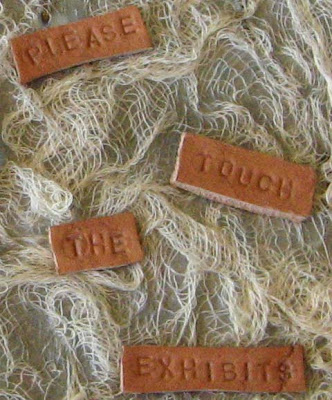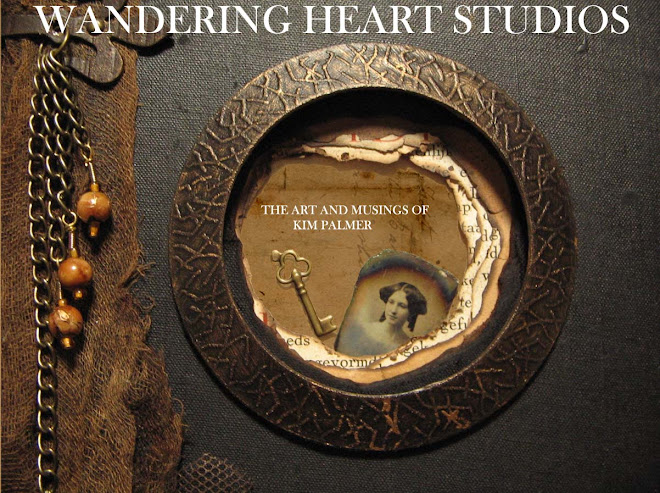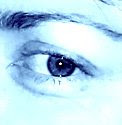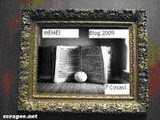I don't say this every day but...

YOU CAN TOUCH!!!
I knew you would be so excited!
Now I last left you deep in the labyrinth. If you were left a little anxious after the last post about what was going to come next...
well now you can relax!
The second section of my contribution to Lisa's book revolves around nature, how we as artists are wont to reproduce it and the beauty it provides us with. It seems since man first stuck his finger in the mud and painted on a cave wall, artists have constantly reinvented, recreated and reproduced the natural world in their artwork. Nature has apparently got the goods when it comes to creative inspiration. So how does that translate into the labyrinth theme of Lisa's book?
When I was thinking about this idea I started to notice the myriad things we are surrounded with every day and how labrynthine the structures of some of these items are. I was gazing at probably the most awful plastic placemat in history in a cheapy store when suddenly it occured to me how much the plastic reminded me of vines or ivy climbing up a wall. Said revolting placemat suddenly wasn't such a bad evil item and promptly came home with me for the grand sum of 20cents AUS, and into the book it went. Some creative chopping here and there, a little copper and voila!

The page is a reflection on mans constant reproduction of nature in art. How we take the forms we find around us and find new ways with available materials to reproduce those forms. The found poetry from the underlying page reads:
Then inspiration came,
too wild this burst of sentiment interrupted true reason?
I think creative ideas are frequently like this. A sudden burst overtakes us and for good or bad out it flows until it's finished. Sometimes the ideas and execution are great, at other times...
well no-one is perfect everyday!
The next page also reflects man's continued drive to represent the labyrinthine form in art, but has taken a somewhat 90 dgree turn in thinking. The page is a representation of celtic knotwork. Celtic knotwork sprang into being around the 8th century AD. It is supposed that originally the forms were created to represent particular significance, but unfortunately the knowledge no longer exists and art historians can come to no consensus on the matter. What is agreed upon in general is that the interlacing patterns represent the unending continuum of life. The crossing and recrossing of the plaits is symbolic of the ongoing connection between the physical and spiritual planes. The three lobed Triquetra (the design used below is a derivative of this form), symbolises the connection between the three planes of existance, mind body and spirit.

YOU CAN TOUCH!!!
I knew you would be so excited!
Now I last left you deep in the labyrinth. If you were left a little anxious after the last post about what was going to come next...
well now you can relax!
The second section of my contribution to Lisa's book revolves around nature, how we as artists are wont to reproduce it and the beauty it provides us with. It seems since man first stuck his finger in the mud and painted on a cave wall, artists have constantly reinvented, recreated and reproduced the natural world in their artwork. Nature has apparently got the goods when it comes to creative inspiration. So how does that translate into the labyrinth theme of Lisa's book?
When I was thinking about this idea I started to notice the myriad things we are surrounded with every day and how labrynthine the structures of some of these items are. I was gazing at probably the most awful plastic placemat in history in a cheapy store when suddenly it occured to me how much the plastic reminded me of vines or ivy climbing up a wall. Said revolting placemat suddenly wasn't such a bad evil item and promptly came home with me for the grand sum of 20cents AUS, and into the book it went. Some creative chopping here and there, a little copper and voila!

The page is a reflection on mans constant reproduction of nature in art. How we take the forms we find around us and find new ways with available materials to reproduce those forms. The found poetry from the underlying page reads:
Then inspiration came,
too wild this burst of sentiment interrupted true reason?
I think creative ideas are frequently like this. A sudden burst overtakes us and for good or bad out it flows until it's finished. Sometimes the ideas and execution are great, at other times...
well no-one is perfect everyday!
The next page also reflects man's continued drive to represent the labyrinthine form in art, but has taken a somewhat 90 dgree turn in thinking. The page is a representation of celtic knotwork. Celtic knotwork sprang into being around the 8th century AD. It is supposed that originally the forms were created to represent particular significance, but unfortunately the knowledge no longer exists and art historians can come to no consensus on the matter. What is agreed upon in general is that the interlacing patterns represent the unending continuum of life. The crossing and recrossing of the plaits is symbolic of the ongoing connection between the physical and spiritual planes. The three lobed Triquetra (the design used below is a derivative of this form), symbolises the connection between the three planes of existance, mind body and spirit.

The page was designed to look like old crumbling plasterwork. Why, just because I wanted to, OKAY! :)
(I like old plasterwork, and I wanted to see if I could!)
Here's the double page spread as it appears in the book.

So having looked at man's continued drive to represent nature in his art, that leads us back to the inspirational forms found in nature itself.
Over the page we go and...

Nature produced the original labyrinths for us as inspiration and we have been reproducing them ever since.
The intricasies of a leaf that reveals its innner skeletal structure as it decomposes. A flower from my garden.
On the other side of the page...
something a little different.

As some of you know, I'm fond of doors in my art.
Couldn't resist this opportunity could I?


Nature produced the original labyrinths for us as inspiration and we have been reproducing them ever since.
The intricasies of a leaf that reveals its innner skeletal structure as it decomposes. A flower from my garden.
On the other side of the page...
something a little different.

As some of you know, I'm fond of doors in my art.
Couldn't resist this opportunity could I?

(Apologies to Lisa, the book will never close again!)
Under the door the cabinet contains...
some of natures best efforts!

The page contains some exhibits including, coral, bees wax, a shell fragment and an insect wing.
What better examples of natures labyrinths could I find!
(Okay, ones that will fit in the book people!)
The pages have been cast in resin then attached to the book. When I first pondered the idea of natural labyrinths and their inclusion in the book I couldn't work out how I was going to be able to post the book successfully across the world. It has to travel constantly between the States, Australia and New Zealand. This constituted a customs nightmare trying to include these items in an altered book until I hit upon the idea of casting the pages in resin. Hopefully Mr. Customs man will have no objections now and the book can travel safely through everyone's hands!
So now you can touch!

The page as it appears fully opened.

The pieces although encased in resin still reveal their structure if you touch them. You can still feel the the items under the resin.
I have created a small magnifier that detaches from the page to help one examine the exhibits in the cabinet.

The page as it appears fully opened.

The pieces although encased in resin still reveal their structure if you touch them. You can still feel the the items under the resin.
I have created a small magnifier that detaches from the page to help one examine the exhibits in the cabinet.

And so to the end of my contribution to Lisa's book. I have had so much fun with this theme and enjoyed finding solutions to obstacles that came with the ideas I wanted to include here. I can't wait for the next book to fly it's way over the waters to me. It will be Lisa Jurists gorgeous book and I am so looking forward to seeing and touching the already gorgeous work that Lisa and Lisa (NO it's not a mistake Lisa J posted to Lisa S!) have put into it!




































